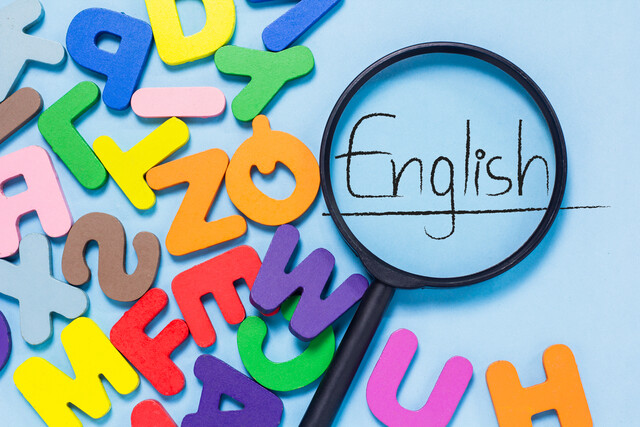Phonics is the relationship between the print and the sounds; in other words, the correlation between the letters and the sounds they make in order to form the words read.
It is the heart and soul, or backbone, of the reading process. While English itself has a complicated set of correlations, it is still this process that provides the student with the key to unlock the printed word. As previously stated, there are 26 letters but approximately forty sounds created by these letters. Additionally, the process is further complicated by the fact that specific sounds can be created by multiple letter formations. For example, the sound /f/, can be represented by the letter f (such as in fish), the letters ph (such as in phone), or the letters gh (such as in the word slough). One sound yes, but multiple spellings which can require a reader to be flexible in their thinking process when attempting to decode unknown words.
In the study of language, letters are referred to as graphemes. The sounds that are made by these letters are referred to as phonemes. A phoneme can only be one sound. Therefore, a word, such as cat, could be described as being made up of three separate phonemes (/c/ /a/ /t/). In order for new readers to be able to look at the printed word and gather meaning, they must be able to use the alphabetic principle.
Alphabetic principle refers to the readers' understanding that there are known and reliable correlations between the letters and sounds. Having an understanding of this process allows a reader to be able to look at the unknown word, apply the information they know about letters and sounds, and determine the word. As described, it appears to be a rather complex task, and it is in fact cumbersome. It is with practice and through ongoing effort that readers become more and more efficient at the process so that it eventually becomes automatic.
The more automatic the process becomes the more information that can be garnered from the reading process. As the end result, and ultimate goal, of all reading is the understanding of information, it is imperative that young children become more automatic with the process of decoding unknown words.
The brain has the ability to hold limited pieces of information in its short-term memory. Typically, a good average number to consider is about five to seven items (thus, why it is generally easy to remember a phone number). When the brain has to hold in its memory all of the words in a decoded manner (sounds, blend sounds together, word) it will find it more cumbersome to gather meaning in an efficient manner. This is one reason why it is important for readers to become efficient at the decoding process, to free space within the short-term memory to focus on comprehension skills.
As stated above, the National Reading Panel found that the most beneficial type of phonics instruction was that which was conducted in a systematic and explicit manner. Systematic instruction is instruction that occurs in a clearly defined sequence, typically where new learning continuously builds upon previously learned information. In this way, additional repetitions and practice opportunities are available to ensure mastery of the skills.
Explicit instruction requires direct teaching of the letter-sound relationship. This would include the major letter-sound combinations that would be found in the majority of printed text. It would involve not only single letter-sounds, but also letter combinations that form their own unique sounds. It goes across all letters (vowels and consonants). Additionally, explicit instruction requires multiple repetitions for the learner in order to ensure mastery.
There are six major types of phonics instruction that can be found in schools. The six types are:
� Analogy-based phonics � phonics approach that uses word families and finding similarities between words to learn new words
� Synthetic phonics � phonics approach where learners are taught how to look at letters and change them into their sounds, then finally blend the sounds together into words
� Embedded phonics � phonics approach where the letter-sound relationships are taught through the text and not in isolation
� Onset-rime phonics � phonics approach where learners combine the first sound in a word (onset), with the rest of the word (rime)
� Analytic phonics � phonics approach where learners are taught how to look at the relationships in already-known words to learn new words; no sounds are produced in isolation
� Spelling phonics � phonics approach where learners break apart (segment) words, typically when writing, and apply their own knowledge of letter sounds to determine what letter to write
Practice at home should consist of review of letter sounds and their application. Encouraging children to sound out unknown words is the first step. Creating word houses (a sheet of paper where all of the words on the page have the same rime � log, dog, hog, bog, etc.) is another strategy to help students recognize commonalities when reading. Then as students begin to look at longer words, it is important to have them refer to the sounds and skills they already know (i.e. doghouse: They might already know the dog part). Having the students keep a journal or writing about events on a trip or vacation is another good strategy to encourage phonics skills. Have the students sound out the words they want to write and write down the corresponding letter that makes that sound(s). Remember it is not imperative at the beginning that the spelling match adult regular spelling; this will develop over time and with practice.
Phonics instruction that is explicit and systematic does not have to be from a purchased program. As described above, it is simply important that the instruction be presented in a logical manner that directly teaches the majority of the letter-sound combinations to the students. Programs or teaching styles that are not systematic may simply teach sounds as they occur in a text, not in any specific order. In this way, they encourage readers to only learn perceived needs by the teacher or the student, which may not provide a solid foundation for students. There are many games and programs that can be used to help, if someone wants to purchase such a program. Hooked on Phonics� is one such program.
There are many critics of phonics instruction. In this way, they point out the numerous spellings, irregular words or other distractions as reasons why it is not necessary to complete phonics instruction. The scientific research indicates that phonics is indeed an important criterion in all reading instruction.
In the end, students who are struggling, or may require additional instruction in reading, may need additional phonics instruction. As systematic, explicit phonics instruction has been shown to: increase comprehension skills and work with all socio-economic levels. However, as is the case with all of the big five ideas in the teaching of reading instruction, it is not the only aspect that is necessary to develop a learner into a good reader. It is a balance of all five areas that is most successful.
























